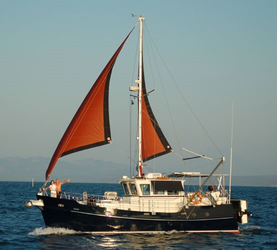I have failed on the boat shed roof design again. Just prior to leaving for the funeral a severe windstorm rolled through my neighborhood with winds gusting in excess of 50 mph. This resulted in the previous roof repair being torn off, ripping the battens and their screws right out of the roof trusses. The repairs have been made, this time the right way for a little over $200. So now in order to save $100 when I originally put the roof on, I have spent $200 more to do it right. A hard lesson to learn and a reminder to just do it right the first time!
I knew I needed a piece of roof material 40' wide by 50' long when I built the boat shed originally. However, a 40' by 100' roll of 6 mil visqueen was around $200. So I bought a 20' by 100' for less than $100 and cut it in half and seamed it together. The seam tape failed under the wind loads back in December so in order to repair that I bought another roll of 20' by 100' visqueen and essentially covered the failed seem with a wide ridge cap of 20' wide visqueen. I had some seam tape left over and I knew that wind could easily get between the first roof and the new ridge cap so I began to tape up that seam. Well I didn't have enough tape, got lazy and never finished it.
Well that was a costly mistake. That's exactly where the failure happened, right were the seam ended and the wind got underneath and ripped the ridge cap off. Surprisingly it was not the plastic that ripped, but the wind load that tore the screws right out of the roof joists. With the battens swinging around with exposed screws tearing into the original roof and the ridge cap. It was a mess and I am getting embarrassed. I recognized the weakness and knew what I could do to prevent it but I didn't. I was kicking myself mentally for quite a few hours. However that was serving no purpose so I needed a new plan.
The new plan was simple enough, do it right! I purchased the 40' x 100' visqueen and installed it with the help of my father. This time I used 2" x 1" oak battens instead 1" x 3/4" pine and bolted them to the knee wall instead of using screws. The bolts were reinforced with 4" x 4" 3/8" plywood "washers". I'll have more details on those on my YouTube channel for Episode 3. Everything seems secure and based on what I've learned I believe it will hold. A fresh winter storm is headed here this afternoon so I may get it tested out sooner rather than later.
When the roof was ripped off it allowed the blowing rain to get inside the boat shed where my keel lofting was still laid out. It got a little wet and had a few tears and wrinkles but it was basically still in good shape. After letting it dry out for a few days I was able to use it to build my patterns.
The patterns were fairly easy and straight forward to do. I used 1/8" plywood, what I believe Mr. Buehler calls "door skin" cut into 2" wide strips for the patterns. I cut them to size and secured them with construction staples and hot glue. I laid them at each station and marked the rabbet. Once again my grandfathers tools got dusted off when I used an at least 40 year old hot glue gun. It still had the glue sticks in the case and it seemed to work well.
Once I have the keel all laminated up i'll be able to lay the pattern on it and mark each station location and it's rabbet.
I also made a trip to Jasper, NY to purchase my wood for the keel, floor timbers and frames. I made the purchase from an ad I found on Craigslist. A young Amish man is relatively new in the sawmill business (Rocky Run Woodworks) and had one of his friends outside the community put the ad up for him. The wood is green but at .60 cents a board foot I can afford to let it dry a little before working with it. He cut it to my exact specifications without any additional costs which is unusual. I ordered boards in the following dimensions: 1.5" by 7" for the keel, 3 1/2" by 9" for the floor timbers and 2" by 5" for the frames.
 |
| This guy had a beard that the hipsters would die for! |
He threw in some shorties and outside cuts with sap wood for free so I should be in pretty good shape wood wise for quite a while. I got it home, stacked and stickered with the help of one of my oldest friends. I was grateful for the help as the 3 1/2" by 9" by 10' were exceptionally heavy! I ended up purchasing about 1100 board feet.
I have been working on creating patterns for some of the keel segments and reviewing the paper plans that Mr. Buehler just delivered. More on those next time.
Thanks for stopping in and be sure to become a follower and check out our video series on YouTube. You can navigate to our YouTube channel by clicking on this link: Sea Dreamer Project YouTube channel
If you have any tips, questions or comments please feel free to post them here, at the message link to the right or email at: contact@seadreamerproject.com
Have a great week!


























No comments:
Post a Comment